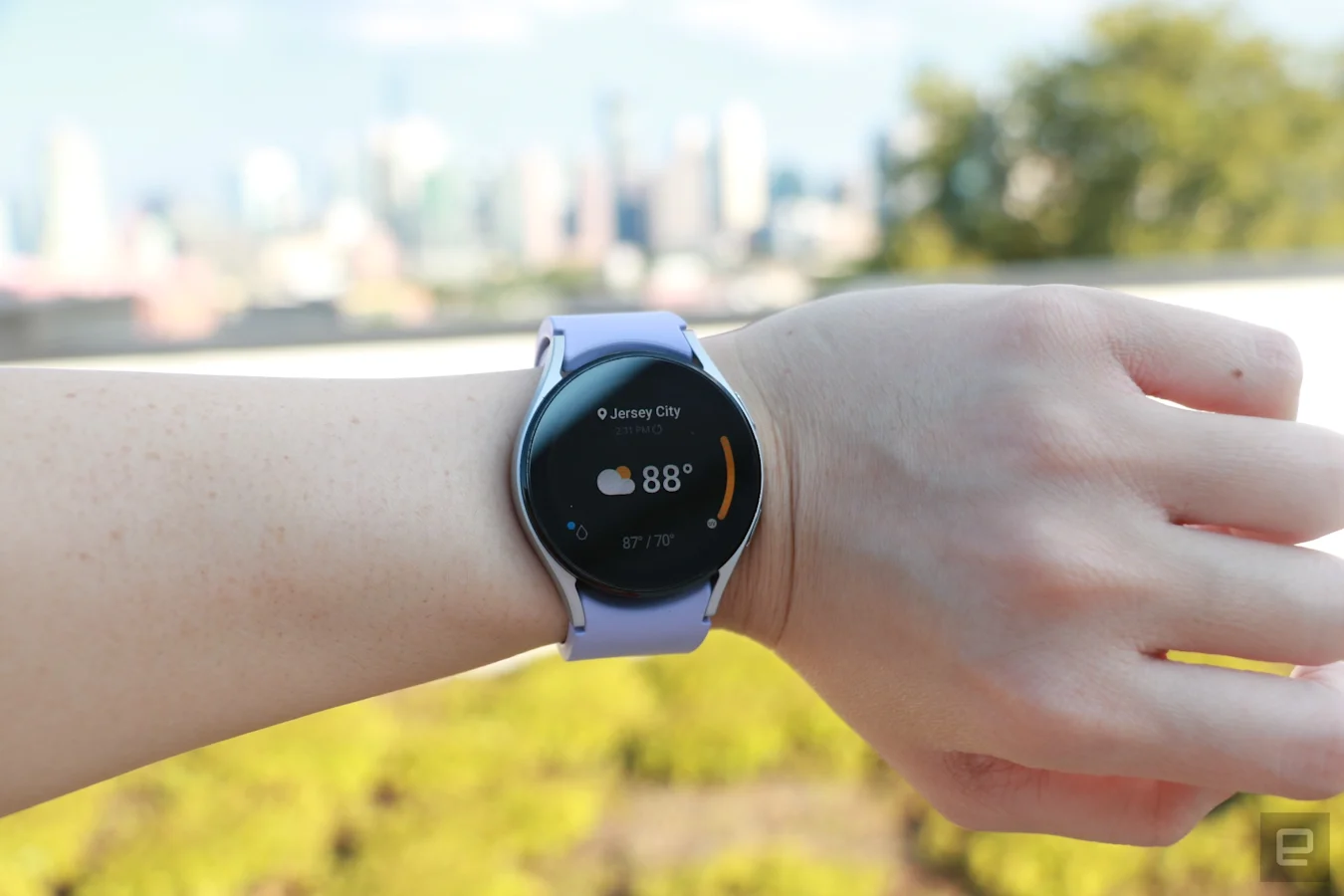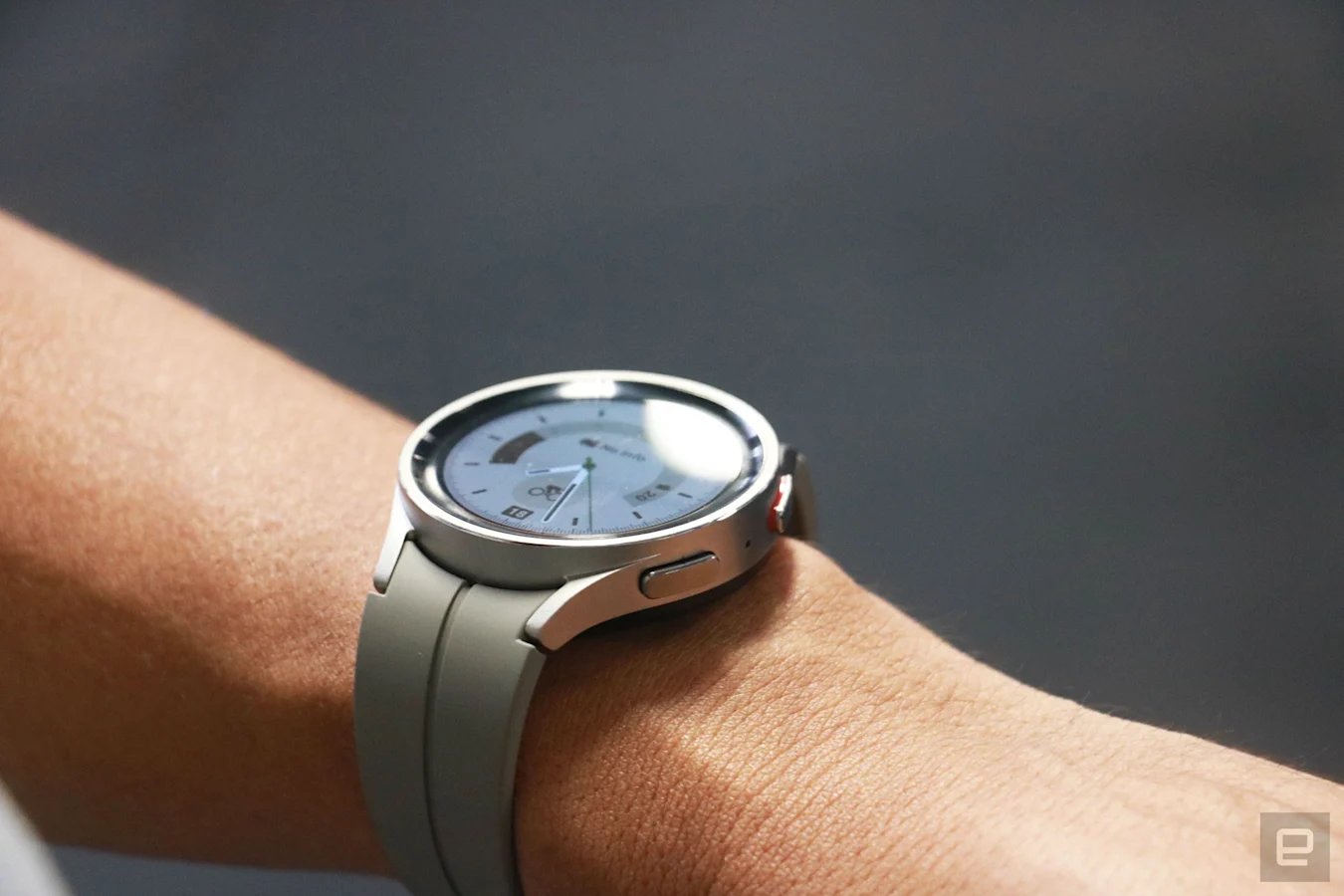Image Credit: Cherlynn Low / Engadget
Health and activity tracking
Samsung has also long been better than most Wear OS watches at monitoring your activity, and the Watch 5 is no different. When I was stuck at my desk for hours on end pounding out this review, it reminded me to get up and move. I have always appreciated that in addition to walking, Galaxy Watches would also suggest movements you could perform at your desk, like torso twists or stretches. Even better, the device would be able to detect exactly how many twists you’ve done — something the Apple Watch and other Wear OS devices don’t do.
In general, Samsung’s system is as proactive as ever. When I got up to walk around after the Watch 5 prompted me to, the device buzzed after I took about a dozen steps to congratulate me for moving. That’s a lot less than Apple’s demands, which can make me feel like I need to pace my room like I’m going mad.
Galaxy Watches are also quicker to recognize when you’ve been moving and will ask if you want to record your walk. The flip side of that is they’re also hyperactive at noticing when you’ve paused and will not only suspend tracking, but will buzz you to let you know it’s not counting the time while you’ve stopped. Chill Samsung!
Cherlynn Low / Engadget
Performance and in use
Besides the sleep coaching feature, not much is different between the Watch 4 and Watch 5 when it comes to software. You’ll still be able to get a body composition reading using the built-in body-impedance analysis (BIA) tool, take ECG scans, reply to messages, control music playback and more. The Watch 5 also uses the same 5nm Exynos processor as the older model, and for the most part was just as responsive. I only really had to wait when creating new watch faces or taking a body fat scan — otherwise, everything happened the instant I tapped the screen.
Speaking of, if you were wondering about the accuracy of the Watch 5’s body composition measurements — it’s surprisingly close to results from more sophisticated systems. I recently tried an InBody scan, which is a more advanced version of BIA like that on the Watch 5. Samsung’s readings were just about two percent off on body fat percent and less than a pound under my skeletal muscle as calculated by the InBody version.
I actually forgot that the Watch 5 is a Wear OS device, because its software still feels so much like Tizen. Besides swiping up and down from the home screen to pull up all apps and settings, the majority of the side-swiping interface feels no different from Samsung’s original OS.

Cherlynn Low / Engadget
One thing I wish Wear OS / Tizen did better was displaying workout information. Apple uses a large, bold font to show how long you’ve been working out, as well as your heart rate and calories burned. Samsung displays similar information, but using a font that’s a lot thinner and smaller. When my Watch 5’s screen was locked during my swim and I couldn’t tap it, I couldn’t see any info at all and had to unlock water mode mid-lap to bump up brightness to the max. Even then, it was only better.
It’s also worth noting that because they’re typically secondary devices, a significant part of the smartwatch experience is interacting with its companion apps on your phone. In this case, you’ll need to install the Galaxy Wearable app to set up your Watch 5, and Samsung Health to see details about your workouts and sleep sessions. In general, these apps were easy to use and navigate and I found settings or health summaries quickly. Samsung also shows what cardio zones you were in during a workout or sleep session, and this information is only coming to watchOS 9 when it’s publicly available later this year.
Battery life and charging
I wore the Apple Watch Series 7 and Galaxy Watch 5 on each wrist for a week and every day they delivered almost exactly the same runtime, though with one caveat. Both devices clocked slightly over a day before conking out, although enabling the Always On Display (AOD) caused the Watch 5 to drain noticeably faster. One night, the Samsung watch dropped to 4 percent by 7:21pm, while the Apple Watch was still holding strong at 38 percent despite also having AOD on.

Cherlynn Low / Engadget
Both watches recharged quickly, so I never had to wait longer than 30 minutes to get enough juice for half a day’s wear. When I wore the watches overnight to test sleep tracking, the Apple Watch used less power than the Galaxy Watch, but the latter actually delivers better results, which seems like a worthwhile tradeoff.
The Pro difference
The Pro model of the Watch 5 typically lasted a few hours longer than the 40mm model with its Always On Display enabled, and I got close to a day more juice with the setting turned off. Though Samsung markets the Watch 5 Pro as having been designed “for the great outdoors,” there’s really little about it that makes it feel that way.
The Pro is noticeably bulkier, too. I have fairly petite wrists, so the 45mm titanium case felt overwhelming. It also has a chunky frame around the screen where a rotating bezel might sit, although there is no mechanical spinner here. While the D-buckle closure makes the Pro fit more securely, it adds to the general heft.
Gallery: Galaxy Watch 5 Pro review | 9 photos
Gallery: Galaxy Watch 5 Pro review | 9 photos
That might not be a bad thing if you don’t mind oversized watches, and the bonus is that the Watch 5 Pro feels strong enough to withstand being smashed against boulders. I had it higher up my forearm when racking kettlebells like I mentioned earlier, so the weights actually landed on its screen. Despite being smacked by 26 pounds of metal, the Watch 5 Pro survived without a scratch, and I continued to run through my reps without much concern. The stronger Sapphire Crystal glass that Samsung uses here definitely held up, at least during my testing.
The other feature differentiating the Pro from the regular Watch 5 is its support for the GPX route format for workouts like hiking and cycling. You’ll have to go into the Samsung Health app on your phone to pick a previous route and export it as a GPX file, go into Hiking or Cycling and import that information. Then, from the Watch 5 Pro, you can select one of the routes you loaded under one of those exercises to start the same journey, and the device will show you turn by turn directions.

Cherlynn Low / Engadget
It’s a little tricky to set up, but potentially helpful for those who are in a new place and want to try out a local route by downloading GPX files from databases. Samsung also added a Track Back feature that will take you home the way you came and it’s only available for hiking or cycling for now.
wrap up
Even though most of the changes Samsung brought to the Watch 5 line are minimal, the fact remains that for Android users, this is the best smartwatch around. I might not like the refined curvature of the underside, but it does make for more reliable sensor readings. The Watch 5 Pro is also a little bulky for my taste and the only real improvement it offers over the regular model (aside from size and durability) is a bit more battery life.
Still, thanks to its well-rounded and capable health and fitness tracking tools, the Watch 5 is one of the best smartwatches around.
All products recommended by Engadget are selected by our editorial team, independent of our parent company. Some of our stories include affiliate links. If you buy something through one of these links, we may earn an affiliate commission.
